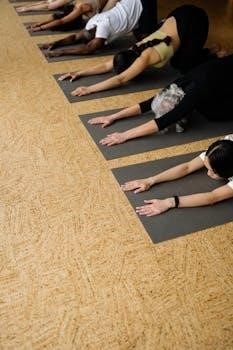si joint stretches pdf

Sacroiliac (SI) Joint Stretches⁚ A Comprehensive Guide
Experiencing lower back, hip, or buttock pain? This guide explores sacroiliac (SI) joint stretches to relieve discomfort. Discover exercises recommended by physical therapists to ease your daily routine. Learn simple moves to improve flexibility, targeting muscles around the SI joint for pain relief.
Understanding SI Joint Pain
Sacroiliac (SI) joint pain, often felt as a dull ache or sharp stab in the lower back, hips, or buttocks, arises from dysfunction in the SI joint. This joint, connecting the sacrum to the ilium bones of the pelvis, plays a crucial role in weight distribution and shock absorption. Pain can stem from various factors, including muscle imbalances, arthritis, trauma, or pregnancy.
Understanding the root cause of SI joint pain is crucial for effective management. While stretches and exercises offer relief by loosening tight muscles and improving joint mobility, identifying the underlying issue is paramount. Strengthening core and hip muscles contributes to joint stabilization, preventing further irritation.
This comprehensive guide delves into SI joint stretches designed to alleviate pain and enhance flexibility. It emphasizes the importance of proper technique and mindful execution to maximize benefits and minimize the risk of exacerbating discomfort. Recognizing when professional help is necessary ensures appropriate diagnosis and treatment for persistent or severe SI joint pain.
Causes and Symptoms of SI Joint Pain
Sacroiliac (SI) joint pain manifests through various causes and symptoms. Common causes include traumatic injuries, such as falls or car accidents, leading to joint inflammation or misalignment. Arthritis, both osteoarthritis and rheumatoid arthritis, can degenerate the SI joint, causing pain and stiffness. Pregnancy hormones can loosen ligaments, increasing joint mobility and susceptibility to pain.
Muscle imbalances, particularly weak core or gluteal muscles, can destabilize the SI joint, contributing to pain. Additionally, differing leg lengths or spinal conditions like scoliosis can place uneven stress on the joint. Symptoms vary, ranging from a dull ache to a sharp, stabbing pain in the lower back, hips, or buttocks.
Pain may radiate down the leg, mimicking sciatica, or be localized to the groin or upper thigh. Prolonged sitting, standing, or physical activity often exacerbates symptoms. Stiffness, limited range of motion, and tenderness upon palpation are also common indicators. Recognizing these causes and symptoms is crucial for accurate diagnosis and targeted treatment strategies;
Benefits of SI Joint Stretches

SI joint stretches offer a multitude of benefits for individuals experiencing pain and discomfort in the lower back, hips, or buttocks. Primarily, these stretches help to alleviate tension and improve flexibility in the muscles surrounding the sacroiliac joint. By targeting muscles like the glutes, piriformis, and hamstrings, stretches can reduce muscle imbalances that contribute to SI joint dysfunction.
Increased flexibility promotes a greater range of motion, making daily activities more comfortable and less painful. Regular stretching can also improve joint mobility, reducing stiffness and enhancing overall joint function. Furthermore, SI joint stretches can help to reduce inflammation and promote healing in the affected area.
By relieving pressure on the SI joint, stretches can decrease nerve compression, alleviating radiating pain that may extend down the leg. Consistent stretching can strengthen the muscles supporting the SI joint, providing stability and preventing future injuries. Ultimately, incorporating SI joint stretches into a routine can improve quality of life by reducing pain, enhancing mobility, and promoting overall well-being.

Effective SI Joint Stretches
Discover effective SI joint stretches to relieve pain and improve mobility. These targeted exercises help increase flexibility and ease tension in the lower back and hips. Learn how to perform each stretch correctly for optimal results.
Knee-to-Chest Stretch
The knee-to-chest stretch is a simple yet effective exercise for relieving SI joint pain. It gently stretches the muscles in the lower back, hips, and glutes, promoting flexibility and reducing tension around the sacroiliac joint.
How to perform the knee-to-chest stretch⁚
- Lie on your back with your knees bent and feet flat on the floor.
- Gently bring one knee towards your chest, using your hands to pull it closer.
- Hold the stretch for 20-30 seconds, feeling a gentle pull in your lower back and hip.
- Slowly release your knee and return to the starting position.
- Repeat with the other leg.
- Perform 2-3 repetitions on each leg.
Important considerations⁚
- Avoid pulling too hard, as this can aggravate your SI joint.
- If you feel any sharp pain, stop the exercise immediately.
- Breathe deeply throughout the stretch.
- You can modify this stretch by bringing both knees to your chest simultaneously.
The knee-to-chest stretch can be incorporated into your daily routine to help manage SI joint pain and improve overall lower back flexibility.
Pelvic Tilt Exercise
The pelvic tilt is a gentle exercise designed to improve core stability and flexibility in the lower back, which can indirectly alleviate SI joint pain. It involves controlled movements that engage the abdominal and gluteal muscles, promoting proper alignment and reducing stress on the sacroiliac joint.
How to perform the pelvic tilt exercise⁚
- Lie on your back with your knees bent and feet flat on the floor.
- Keep your arms relaxed at your sides.
- Gently flatten your lower back against the floor by tightening your abdominal muscles and tilting your pelvis upward.
- Hold this position for 5-10 seconds.
- Slowly return to the neutral position, maintaining a slight curve in your lower back.
- Repeat this movement for 10-15 repetitions.
Important considerations⁚
- Focus on controlled movements, avoiding any sudden jerks.
- Breathe deeply throughout the exercise.
- Engage your core muscles throughout the movement.
- Avoid arching your back excessively.
The pelvic tilt exercise can be performed daily to improve core stability, reduce lower back pain, and promote healthy SI joint function. It can be a valuable addition to your SI joint pain management strategy.
Piriformis Stretch
The piriformis muscle, located deep in the buttock, can contribute to SI joint pain when it becomes tight or inflamed. This tightness can compress the sciatic nerve, leading to pain that radiates down the leg. The piriformis stretch aims to release tension in this muscle, alleviating pressure on the SI joint and sciatic nerve.
How to perform the piriformis stretch⁚
- Lie on your back with your knees bent and feet flat on the floor.
- Cross the ankle of your affected leg over the knee of your opposite leg.
- Gently pull your uncrossed thigh towards your chest, using your hands to deepen the stretch.
- You should feel a stretch in the buttock of your crossed leg.
- Hold the stretch for 20-30 seconds.
- Repeat 2-3 times on each side.
Modifications⁚
- If you cannot reach your thigh, you can gently press on your crossed knee to deepen the stretch.
- For a more intense stretch, pull your thigh closer to your chest.
Important considerations⁚
- Avoid forcing the stretch.
- Listen to your body and stop if you feel any sharp pain.
- Breathe deeply throughout the exercise.

Regularly performing the piriformis stretch can help to improve flexibility, reduce tension in the buttock muscles, and alleviate SI joint pain associated with piriformis syndrome.
Lumbar Roll
The lumbar roll is a gentle stretching exercise designed to increase mobility and reduce stiffness in the lower back and surrounding structures, including the SI joint. By encouraging a gentle twisting motion, this stretch can help to release tension in the muscles and ligaments that support the SI joint, promoting better alignment and reducing pain.
How to perform the lumbar roll⁚
- Lie on your back with your knees bent and feet flat on the floor. Extend your arms out to the sides, forming a “T” shape.
- Keep your shoulders pressed firmly against the floor.
- Gently rotate your knees to one side, allowing them to fall towards the floor. You should feel a gentle stretch in your lower back and hips.
- Hold this position for a few seconds.
- Return your knees to the center position.
- Repeat the movement on the opposite side.
- Continue alternating sides for 10-15 repetitions on each side.
Important considerations⁚
- Move slowly and deliberately throughout the exercise.
- Avoid forcing the movement or pushing beyond your comfortable range of motion.
- If you experience any sharp pain, stop the exercise immediately.
- Breathe deeply throughout the exercise, exhaling as you rotate your knees to the side.
The lumbar roll can be a beneficial addition to your SI joint pain management routine, helping to improve flexibility, reduce muscle tension, and promote overall spinal health.
Bridge Exercise
The bridge exercise is a fantastic way to strengthen the glutes, hamstrings, and core muscles, all of which play a crucial role in stabilizing the pelvis and supporting the SI joint. By strengthening these muscles, you can improve the alignment of the SI joint, reduce stress on the joint, and alleviate pain. This exercise also promotes hip extension, which can help to improve flexibility and range of motion in the lower back and hips.
How to perform the bridge exercise⁚
- Lie on your back with your knees bent and feet flat on the floor, hip-width apart.
- Keep your arms at your sides with your palms facing down.
- Engage your core muscles and gently tilt your pelvis back.
- Press through your heels to lift your hips off the floor, creating a straight line from your knees to your shoulders.
- Squeeze your glutes at the top of the movement.
- Hold this position for a few seconds.
- Slowly lower your hips back down to the floor.
- Repeat for 10-15 repetitions.
Important considerations⁚
- Maintain a straight line from your knees to your shoulders throughout the exercise.
- Avoid arching your back excessively.
- Engage your core muscles to stabilize your spine.
- Breathe deeply throughout the exercise, exhaling as you lift your hips.
The bridge exercise is a safe and effective way to strengthen the muscles that support the SI joint, helping to reduce pain and improve overall function.

Additional Exercises and Considerations
Beyond targeted stretches, strengthening core and hip muscles is vital for SI joint stability. Know when professional help is needed. These exercises, alongside proper guidance, offer a holistic approach to managing SI joint pain and improving overall well-being for lasting relief and function.
Strengthening Core and Hip Muscles
While stretching alleviates tension around the SI joint, strengthening the core and hip muscles provides crucial stability. A strong core acts as a natural brace, supporting the spine and pelvis, thereby reducing stress on the SI joint. Weak core muscles can lead to improper biomechanics, exacerbating SI joint pain.
Exercises like planks, side planks, and bird-dog exercises effectively engage the core. Hip strengthening exercises, such as glute bridges, clamshells, and hip abductions, target the muscles responsible for pelvic stability and proper leg alignment. These exercises ensure the pelvis is well supported.
Combining core and hip strengthening creates a balanced musculoskeletal system, promoting optimal SI joint function. Consistent training helps prevent muscle imbalances that irritate the SI joints. Always perform exercises with proper form to maximize benefits and minimize the risk of injury. Seek guidance from a physical therapist or certified trainer for personalized recommendations and technique correction. They can tailor a program that addresses specific needs and limitations, ensuring safe and effective strengthening.
Remember, strengthening is not about lifting heavy weights but about building endurance and stability. Focus on controlled movements and maintaining proper posture throughout each exercise. Regular strengthening will reduce pain.
When to Seek Professional Help
While SI joint stretches and exercises can provide significant relief, it’s essential to recognize when professional help is necessary. Persistent or worsening pain despite consistent self-care warrants a consultation with a healthcare professional. If pain interferes with daily activities, such as walking, sitting, or sleeping, seeking guidance is crucial;
Experiencing neurological symptoms like numbness, tingling, or weakness in the legs or feet necessitates prompt medical attention. These symptoms may indicate nerve compression or other underlying conditions requiring specialized care. A physical therapist can conduct a thorough evaluation to determine the root cause of your SI joint pain.
They can develop a personalized treatment plan that addresses your specific needs. This plan may include manual therapy, targeted exercises, and modalities to reduce pain and restore proper joint mechanics. If conservative treatments fail to provide adequate relief, your healthcare provider may recommend further diagnostic testing, such as imaging studies, or consider other interventions, like injections.
Don’t hesitate to seek professional help if you’re unsure about the best course of action. Early intervention can prevent chronic pain and improve long-term outcomes. A healthcare professional can offer expert guidance and support to help you manage your SI joint pain effectively and return to an active, pain-free life. Self-treating is not always best.




